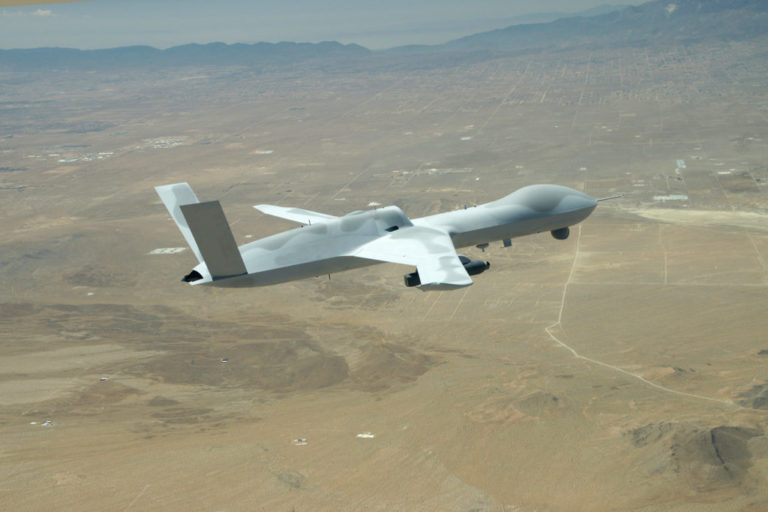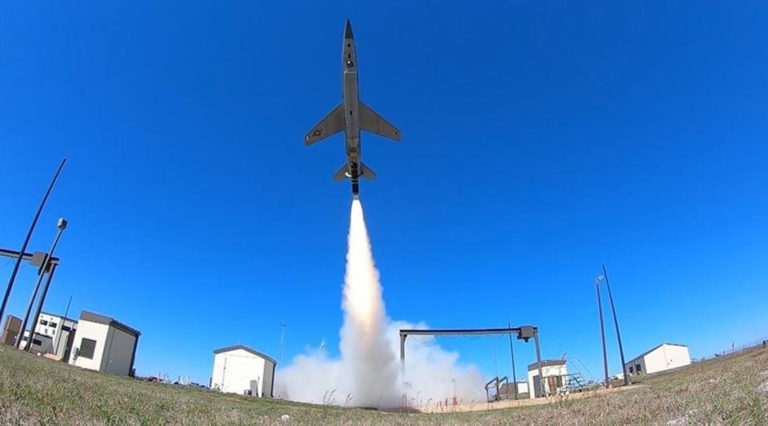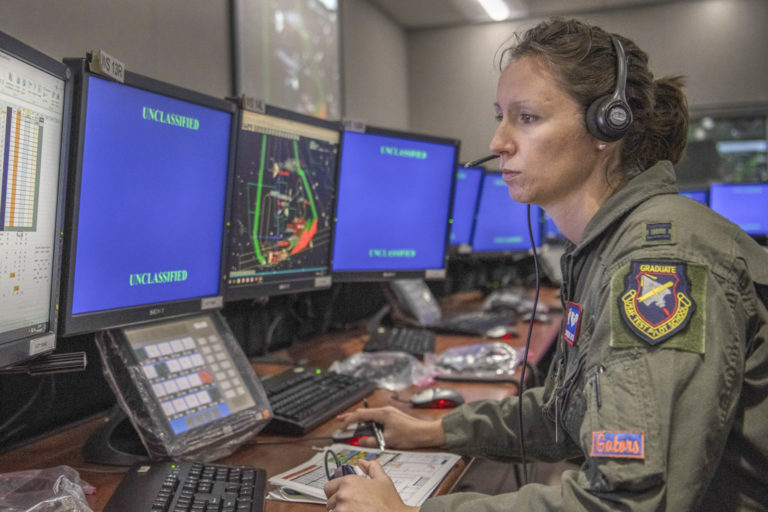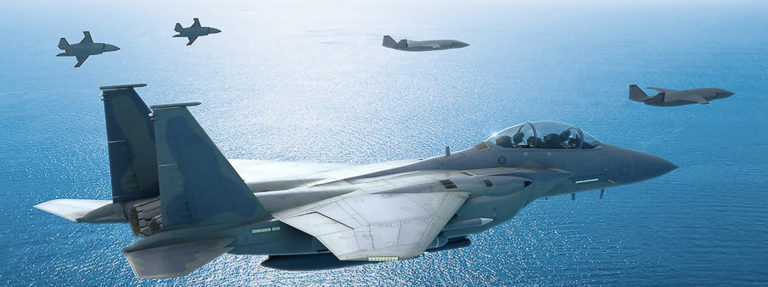The Airforce is developing semi-autonomous, low-cost aircraft to augment its crewed combat jets in a variety of missions.
Robots will join the Combat Air Forces within the next decade, flying alongside manned airplanes, bearing extra munitions, assisting with surveillance and jamming, and even making kamikaze attacks to defend their wingmen.
These Low-Cost Attritable Aircraft Systems (LCAAS), in development since 2015, seek to affordably increase the size and capability of the fleet without adding more pilots or the airborne life-support systems they require. Unlike manned systems, these aircraft are designed for short operational lives and will never go through depot-level maintenance or service-life extensions.
What constitutes “low cost” is in the eye of the beholder. Gen. Mark D. Kelly, head of Air Combat Command, said in August that he’s keenly interested in having an unmanned, stealthy, jamming aircraft for use as an adversary for training fifth-generation fighter pilots. Such an aircraft, provided it can demonstrate “a significant amount of endurance,” would be valuable if it could be had for a quarter the cost of a manned “Red Air” platform. “That, to me, is ‘low cost,’ ” he said.
Kelly acknowledged “nothing is cheap” and said the term “attritable” helps set the parameters. He predicted such aircraft will become “a growth industry.”
Brig. Gen. Dale R. White, program executive officer for fighters and advanced aircraft, defined low cost as being “in the single-digit millions” for the aircraft itself. The ultimate price tag, however, will be determined by “the missions we put on it.” As payloads and sensors are added, the fully loaded price “is going to grow to an expensive number,” White cautioned.
We need to get the one ‘win’ and prove the concept; prove the capability and then have it accelerate from there.
Maj. Gen.Heather Pringle, commander of Air Force Research Laboratory
“We need to get the vehicles down into the single digit [millions of dollars] … but to be largely driven by the threat of the day,” White said. The more capable the systems, the less expendable they become in combat, he said.
White drew a distinction between low-cost attritables and “swarming” unmanned aircraft, which will be “a much cheaper price point because you’re talking very small, but capable, vehicles.”
A driving factor in developing low-cost attritable aircraft is the increasing sophistication of adversary air defenses, which have become harder to penetrate and more lethal the longer an aircraft lingers near them. Expendable aircraft offer a more affordable and lower-risk means to attack such defenses, compared to high-end piloted jets.
Maj. Gen. Heather L. Pringle, head of AFRL, indicated there are still trade-offs to be made to help senior leaders understand how the costs of such aircraft change based on desired range, payload, and sophistication.
“We’re still putting the different pieces and parts together,” she said. The aim is to develop common elements so the resulting vehicles “are easier to plug-and-play.” A common “chassis” could support mission-specific payloads and modules for defense suppression, intelligence, surveillance, and reconnaissance, or as a missile carrier. She said engineers are borrowing biological terms, like “genus” and “subspecies” as they tailor requirements for specific roles.


Flag 21-2 to test the Skyborg Autonomy Core System. General Atomics
Beyond Reaper
Unlike today’s unmanned aerial systems, such as the MQ-9 Reaper, these next-generation systems will fly without human operators. Rather, they will autonomously operate in conjunction with human pilot partners, whether attacking or jamming or watching that pilot’s “six” to protect against enemies. At least for now, only a human will be able to order them to release weapons. Another “nice-to-have” goal of the program is to develop aircraft that don’t necessarily need runways to launch or recover from, which would expand the number of locations from which LCAAS could operate. This would tie in with the Air Force’s Agile Combat Employment scheme, which seeks to broadly distribute forces to widespread locations in a conflict, thus complicating the attack problem for an enemy that wants to deny USAF the ability to operate. The Air Force has dubbed the brains inside LCAAS “Skyborg,” though the name has been frequently misconstrued as describing the aircraft itself. Skyborg is the artificial pilot that allows this class of systems to fly the aircraft without constant attention from a human operator. Within Skyborg is the Autonomy Core System, or ACS, which is government-owned intellectual property that can be applied to any aircraft the government chooses. Skyborg was named one of the Air Force’s marquee “Vanguard” technology efforts in 2019. Skyborg will require platform-specific programming to make best use of whatever LCAAS it’s flying. To date, Skyborg has “flown” the Kratos XQ-58 Valkyrie, the Kratos UTAP-22 Mako, and the General Atomics MQ-20 Avenger. Flying the system on aircraft built by two companies “demonstrates its … portability,” Pringle said. Yet its autonomy will be limited. “We’re not delivering artificial intelligence with this program,” Pringle said. “We may add it at some point in the future, but we want this to be a trusted platform, where operators are comfortable partnering in the manned/unmanned teaming.” The goal isn’t to have Skyborg “out there alone and unafraid and operating on its own.”The First LCAAS? The first Low-Cost Autonomous Attritable System may well be a stealthy, hard-turning jet meant to be a sparring partner for pilots of fifth-generation F-35s and F-22s, said Gen. Mark D. Kelly, head of ACC. Replicating adversary air will be ACC’s first “toe in the water” for such aircraft. Blue Force Technologies was expected to receive a contract in September to develop its “Fury” jet for that role. The aircraft could potentially bear a new “FQ” nomenclature to signify a fighter drone. It would have reduced radar signature and the ability to make 9G turns, with enough endurance to fight all day on a single tank of gas. Company president Scott Bledsoe said the 28-foot-long, 17-foot wingspan Fury will be able to achieve Mach .95. The jet will have an open architecture to support payloads and equipment from other suppliers without involvement from Blue Force, according to Bledsoe. Fury could help ease ACC into operating with LCAAS, said former F-22 pilot and Blue Force adviser Andrew Von Timmeren. Combat pilots “need to practice manned/unmanned teaming” in a nonlethal environment before going to war with it, he said. Pilots need to develop trust in such systems, or else they will “ask you to just leave it home.” Getting comfortable with an LCAAS in the Red Air mode—demonstrating that it “won’t crash into me or crash into the ground”—will let pilots be more open-minded about partnering with the jets in real combat. Before he and other combat pilots will trust it in wartime, he said, “I need it to … roll around in the mud with me and my bros.”
Thus, it’s essential to understand Skyborg as an “autonomous collaborative platform,” Pringle said.
“In autonomy, the pilot would tell the vehicle what to do, and not how to do it,” she said, noting that the vehicle will execute according to its programming. The Air Force sees AI as taking that to another level, such that it “learns on its own what to accomplish and how to accomplish it,” Pringle said. “That’s not where we’re going with…manned/unmanned teaming.”
Nor will unmanned systems be able to overrule a teamed pilot by determining some other target is more urgent. But by being able to follow a pilot’s commands, Skyborg does represent a new sophistication because it does not require “inputting those commands and executing stick maneuvers to get there.”
With LCAAS, Pringle said, there will be “a lot less babysitting.”


the first for the Skyborg suite of autonomous flight controls that will be the brains of a new generation of low-cost attritable aircraft. Kratos
A Kratos UTAP-22—derived from the BQM-167A aerial target—made a rocket-powered takeoff in April from a ground vehicle and then flew for two hours and 10 minutes at Tyndall Air Force Base, Fla. Skyborg showed it could stay within “geo-fences” and perform “coordinated maneuvering” with manned aircraft, the Life Cycle Management Center said in a press release. White called the test “the first step in a marathon of progressive growth for Skyborg technology.”
Skyborg flew in June on the Avenger, GA’s privately financed, low-observable aircraft. During an Orange Flag exercise at Edwards Air Force Base, Calif., a human operator guided the jet from takeoff to altitude, then handed off control to the automated systems which flew it for the remainder of the two hour, 30-minute flight.
Kratos’ XQ-58A Valkyrie has flown in five experiments, most recently with a version of Skyborg. The 29-foot-long angular aircraft offers what Kratos president Steve Fendley called “fighter-like” performance. In a December 2020 test flight, the aircraft flew formation with an F-22 and F-35, and operated as a communications gateway through which the two fighter jets could communicate. That demonstration was opportunistic, however, and is not seen as a typical mission for LCAAS.
While Skyborg is still considered a technology development effort, White said he expects it to become a program of record—meaning it will eventually go into production—in 2023, “as originally planned.” In August, the Life Cycle Management Center announced that Kratos received $13.2 million and General Atomics received $7 million for further work on the Autonomous Core System. The contracts support further experimentation and integration of Skyborg aircraft in “large-force exercises.” These deals followed 2020 contracts where Kratos got $37.7 million, General Atomics $14.3 million, and Boeing $25.7 million to work on Skyborg.
White said in August that the transition to a program of record would have to be “balanced with all of the other requirements we have” across the fighter portfolio. “There’s still some amount of work that we want to do, with respect to both the platform and the autonomy piece before we make the transition,” he said.

Atomics MQ-20 Avenger and fighter aircraft during the Exercise Orange 21-2. The Air Force calls Orange Flag it’s “premier multi-domain test event,” and it was run
in combination with Eglin Air Force Base’s Emerald Flag exercise. Tech. Sgt. Robert Cloys


modular aircraft are being developed in partnership with Australia, and are expected to fly missions independently using artificial intelligence. Boeing illustration

Nevertheless, “I will tell you that we’ve certainly got the attention of our leadership in terms of what we can do with these capabilities and we’re pretty excited about where we’re going.”
Pringle describes a “healthy skepticism” about LCAAS and the need to develop operators and training. Human factors engineers must work out how pilots in F-35s send instructions to an LCAAS flying in formation, for example. That’s why experimentation is essential.
In a more distant future, Pringle said there’s “nothing that would prevent” Skyborg from being applied to other platforms—not just bombers, as Ray suggested, but transports or tankers. But “we’re not on that path, right now.”
First, AFRL needs to build that sense of “partnership and trust” with the Combat Air Forces to show the concept’s full potential, and that requires field-proven demonstrations. “There’s more work to be done,” she stated.